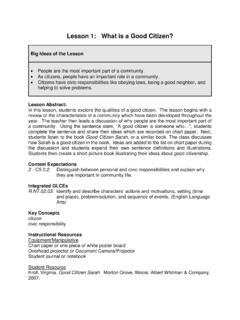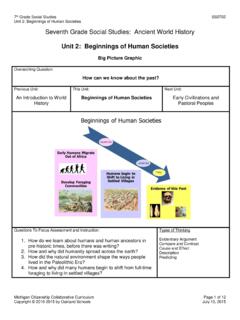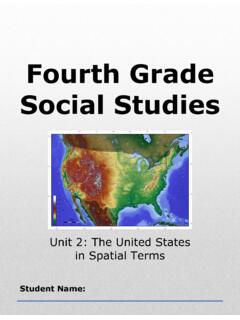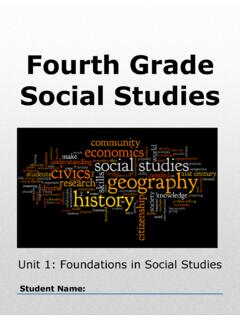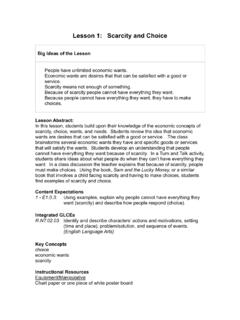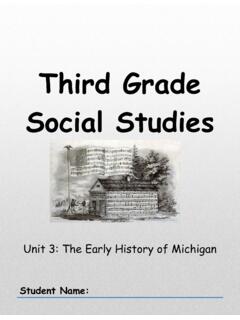Transcription of Fifth Grade Social Studies: Integrated Early American History
1 Integrated Early American History SS0503 Colonization and Settlement Michigan Citizenship Collaborative Curriculum Page 1 of 14 Oakland Schools October 25, 2012 Fifth Grade Social studies : Integrated Early American History Unit 3: Colonization and Settlement Big Picture Graphic Overarching Question: Why did different colonial regions develop in North America? Previous Unit: Three Worlds Meet This Unit: Colonization and Settlement Next Unit: Life in Colonial America Questions To Focus Assessment and Instruction: 1. How did push and pull factors of migration influence the settlement of different colonial regions in North America?
2 2. How did the geography of North America affect the settlement patterns and the economic development of each colonial region? 3. How did cultural differences and similarities between Europeans and American Indians influence their interactions? Integrated Early American History SS0503 Colonization and Settlement Michigan Citizenship Collaborative Curriculum Page 2 of 14 Oakland Schools October 25, 2012 Graphic Organizer Integrated Early American History SS0503 Colonization and Settlement Michigan Citizenship Collaborative Curriculum Page 3 of 14 Oakland Schools October 25, 2012 Historical Overview Migration studies are best understood through the lens of push and pull factors, and the European peopling of North America is no different.
3 Several principal groups - the English, French, Spanish, and Dutch - were driven to North America by myriad factors, including but not limited to enclosure1, mercantilism2, colonial competition, and religious aspiration. Their arrival to North America was met by a varied indigenous response that contributed to the milieu that was the Early New World. Along with the forced arrival of enslaved Africans in 1619, this incredible situation eventually developed into three distinct colonial societies: the New England colonies , the Middle colonies , and the southern colonies . Tragedy and failure are words that come to mind when thinking of Early English attempts to settle the Chesapeake region of what would become the southern colonies .
4 From the disaster at Roanoke to the starving time of the Jamestown colony, the English commercial experiment in Virginia was saved by one contentious development: the cultivation and emergence of a thriving tobacco economy. Faced with growing demand for the intoxicating crop from the Old World, New World farmers expanded in terms of space and labor force to meet market pressures. Driven by the allure of greater profits, plantation farmers pushed increasingly for the expansion of forced or unfree labor, which contributed significantly to the eventual development of slavery throughout the South. Unlike the commercial motive driving the initial English colonies in the South, Puritan discontent fueled English settlement of the New England colonies .
5 In September 1620, a group of Separatists (the Pilgrims) aboard the Mayflower sailed from Plymouth, England for the New World to create a new godly community. After originally aiming for Virginia, the Pilgrims eventually ended up on Cape Cod, stepping ashore at Plymouth Rock on December 21, 1620. The New England colonies developed along a different path from their southern cousins. In general, instead of being characterized by a growing population of forced labor and large plantations, the New England colonies saw the rise of the small independent town as the centerpiece of life; along with varied economic activities, including agriculture, iron working, ship building, and small-scale manufacturing.
6 Finally, the relatively diverse 1 Enclosure is the process which ends traditional rights such as mowing meadows for hay, or grazing livestock on common land. Once enclosed, these uses of the land become restricted to the owner, and it ceases to be common land. In England and Wales the term is also used for the process that ended the ancient system of arable farming in open fields. Under enclosure, such land is fenced (enclosed) and deeded or entitled to one or more owners. 2 Mercantilism was an economic system that sought to unify and increase the power and monetary wealth of a nation by strict governmental regulation of the entire national economy.
7 The regulatory policies were designed to secure an accumulation of bullion (mostly gold), export more than import (a favorable balance of trade), and establish foreign trading monopolies. Middle School Foundations (see Grade 8, ) Describe the ideas, experiences, and interactions that influenced the colonists decision to declare independence by analyzing colonial ideas about government ( , limited government, republicanism, protecting individual rights and promoting the common good, representative government, natural rights) experiences with self-government ( , House of Burgesses and town meetings). Integrated Early American History SS0503 Colonization and Settlement Michigan Citizenship Collaborative Curriculum Page 4 of 14 Oakland Schools October 25, 2012 and generally more tolerant Middle colonies were a kind of middle ground, especially in terms of diverse immigration patterns and varied interactions between indigenous and European groups.
8 Unlike either the small town Puritan life of New England or the increasingly agricultural and unfree life in the southern colonies , the Middle colonies developed along much more varied lines. In addition to the general patterns of colonial societies outlined above, there also existed different general modes of settlement/native interaction for the three largest European groups to conquer North America: the English, the French, and the Spanish. Of particular interest to the Atlantic seaboard colonies are the differences between the English and French styles. Influenced by their experiences with the Irish, Early English leaders desired a plantation model of settlement in which they would literally attempt to transplant their entire English society to the New World, from everyday patterns of life to vegetation, all the while keeping indigenous Americans separate and apart from their communities.
9 The French, who were active settlers of what is now Canada, the Great Lakes, and the Ohio River Valley, practiced a much different form of settlement. Influenced by a large fur trapping and Jesuit presence, the French did not push indigenous Americans back, but rather created societies with them, relying on them for their survival and continued growth in the New World. This different approach not only established different demographic patterns among the French and English in the New World, but also laid the foundations for the epic eighteenth century clash for control of North America: The French and Indian War (the Seven Years War).
10 Challenges for Students: Combining temporal and spatial scales will likely present problems for students. Previously in the MC3 grades K-4, students explored the physical geography of places such as their neighborhood, local community, and the state of Michigan. They explored how these physical features or characteristics influenced the development of human characteristics. For example, towns built near rivers have bridges to cross them. In exploring natural characteristics of the United States, students examined the Grand Canyon and how humans modified the surrounding environment by creating hotels, stores, parking lots, etc.
